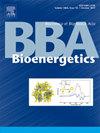通过光亲和标记揭示醋酸原型抑制剂与线粒体复合体I的动态结合。
IF 2.7
2区 生物学
Q2 BIOCHEMISTRY & MOLECULAR BIOLOGY
引用次数: 0
摘要
从番荔枝科植物家族中分离出来的乙酰素是线粒体nadh -泛醌(UQ)氧化还原酶(复合体I)的有效抑制剂。由于acetogenins与其他复合物I抑制剂具有明显不同的化学框架,研究它们的抑制作用为复合物I抑制的机制提供了有价值的见解。结合~35 Å-long乙酰原蛋白衍生物的小鼠配合物I的低温电镜结构表明,乙酰原蛋白沿着预测的uq通道的全长结合,其γ-内酯环指向铁硫簇N2。然而,这种结合模式并不能完全解释各种醋酸原蛋白衍生物的构效关系。为了进一步阐明它们的抑制机制,我们在牛心脏SMPs中进行了光亲和标记实验,使用光反应性乙酰原素衍生物DLA-1,在γ-内酯环附近含有一个小的光可性重氮嘧啶。DLA-1标记了复合体I亚基49-kDa和ND1,它们分别定义了规范uq访问隧道的“顶部”和“底部”区域的结构。蛋白质组学分析显示,ND1中的标记位点不在隧道内部,而在49-kDa亚基的情况下,隧道内部区域的一部分被标记。为了研究乙酰源蛋白结合的分子基础,我们在uq通道中对DLA-1和天然乙酰源蛋白类似物进行了原子分子动力学模拟。模拟数据表明,DLA-1相对刚性,但具有多种构象,并与隧道中的多个区域相互作用,包括光亲和标记识别的残基。基于这些结果,我们讨论了醋酸原类似物与配合物I的结合模式。本文章由计算机程序翻译,如有差异,请以英文原文为准。

Dynamic binding of acetogenin-type inhibitors to mitochondrial complex I revealed by photoaffinity labeling
Acetogenins isolated from the Annonaceae plant family are potent inhibitors of mitochondrial NADH-ubiquinone (UQ) oxidoreductase (complex I). Since acetogenins have a markedly different chemical framework from other complex I inhibitors, studying their inhibitory action offers valuable insights into the mechanism of complex I inhibition. A cryo-EM structure of mouse complex I with a bound ~35 Å-long acetogenin derivative suggested that acetogenins bind along the full length of the predicted UQ-accessing tunnel, with their γ-lactone ring orientating toward the iron‑sulfur cluster N2. However, this binding mode does not fully explain the structure–activity relationships of various acetogenin derivatives. To further elucidate their inhibition mechanism, we conducted photoaffinity labeling experiments in bovine heart SMPs using a photoreactive acetogenin derivative DLA-1, containing a small photolabile diazirine near the γ-lactone ring. DLA-1 labeled both the complex I subunits 49-kDa and ND1, which define the architecture of “top” and “bottom” regions of the canonical UQ-accessing tunnel, respectively. Proteomic analysis revealed that the labeled sites in ND1 are not within the tunnel's interior, whereas in the case of 49-kDa subunit, part of the tunnel's inner region is labeled. To investigate the molecular basis of acetogenin binding, we performed atomistic molecular dynamics simulations of DLA-1 and a natural-type acetogenin analog in the UQ-accessing tunnel. The simulation data indicate that DLA-1 is relatively rigid yet adopts multiple conformations and interacts with several regions in the tunnel including the residues identified by photoaffinity labeling. Based on these results, we discuss the binding modes of acetogenin analogs to complex I.
求助全文
通过发布文献求助,成功后即可免费获取论文全文。
去求助
来源期刊

Biochimica et Biophysica Acta-Bioenergetics
生物-生化与分子生物学
CiteScore
9.50
自引率
7.00%
发文量
363
审稿时长
92 days
期刊介绍:
BBA Bioenergetics covers the area of biological membranes involved in energy transfer and conversion. In particular, it focuses on the structures obtained by X-ray crystallography and other approaches, and molecular mechanisms of the components of photosynthesis, mitochondrial and bacterial respiration, oxidative phosphorylation, motility and transport. It spans applications of structural biology, molecular modeling, spectroscopy and biophysics in these systems, through bioenergetic aspects of mitochondrial biology including biomedicine aspects of energy metabolism in mitochondrial disorders, neurodegenerative diseases like Parkinson''s and Alzheimer''s, aging, diabetes and even cancer.
 求助内容:
求助内容: 应助结果提醒方式:
应助结果提醒方式:


